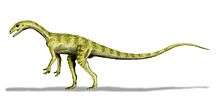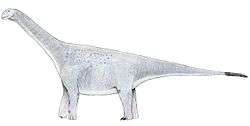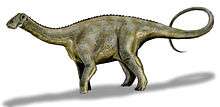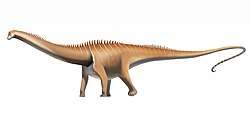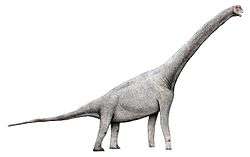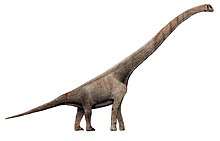Bagualosaurus
Bagualosaurus is a genus of sauropodomorph dinosaur from the Santa Maria Formation of Brazil, dating to around 230 million years ago in the Carnian of the Late Triassic.[1] It includes one species, Bagualosaurus agudoensis.
| Bagualosaurus | |
|---|---|
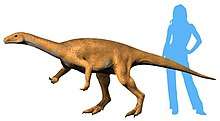 | |
| Restoration | |
| Scientific classification | |
| Kingdom: | Animalia |
| Phylum: | Chordata |
| Clade: | Dinosauria |
| Clade: | Saurischia |
| Suborder: | †Sauropodomorpha |
| Genus: | †Bagualosaurus Pretto, Langer & Schultz, 2018 |
| Species: | †B. agudoensis |
| Binomial name | |
| †Bagualosaurus agudoensis Pretto, Langer & Schultz, 2018 | |
Discovery
In 2007, in a ravine at the outcrop of Janner, near Agudo in Rio Grande do Sul, a sauropodomorph skeleton was excavated. It was removed in a single block of stone. For five years it remained unprepared in the collection of the Laboratório de Paleovertebrados da Universidade Federal do Rio Grande do Sul, curated by Cesar Leandro Schultz. In 2012, Flávio Augusto Pretto began to study the specimen. In 2018, Pretto, Max Cardoso Langer and Schultz named and described the type species Bagualosaurus agudoensis. The generic name is derived from bagual, "strongly built fellow" in the dialect of Rio Grande do Sul, in reference to the strong hindlimbs. The specific name refers to the provenance from Agudo.[1]

The holotype, UFRGS-PV-1099-T, has been found in a layer of red mudstone of the Candelária sequence dating from the Carnian. It consists of a partial skeleton with skull. It contains the lower parts of the skull, the lower jaws, nine back vertebrae, three sacral vertebrae, two tail vertebrae, ribs, belly ribs, chevrons, both ilia, the right pubic bone, both thighbones, both shinbones, both calfbones, and the left foot. The skeleton was partly articulated but has been damaged by erosion. It was found on its back with the hindlimbs pulled up, a rare position for archosaurian fossils.[1]
Description
Bagualosaurus was a modest-sized basal sauropodomorph, measuring approximately 2.5 metres (8.2 ft) in length that, based on its teeth, was a herbivore.[2] Features of its skull and dental structure are similar to later Norian sauropodomophs such as Pantydraco, Efraasia and Plateosaurus. However, its post-cranial skeleton resembles earlier forms. Likewise, it is somewhat smaller than Norian sauropodomorphs, yet significantly larger than other sauropodomorphs of its time, suggesting that it is transitional between the sauropodomorphs of its time and their later Norian descendants.
See also
References
- Flávio A. Pretto; Max C. Langer; Cesar L. Schultz (2018). "A new dinosaur (Saurischia: Sauropodomorpha) from the Late Triassic of Brazil provides insights on the evolution of sauropodomorph body plan". Zoological Journal of the Linnean Society. in press. doi:10.1093/zoolinnean/zly028.
- "Estudo põe mais um dinossauro na pré-história do País – Brasil". Archived from the original on 2018-05-26. Retrieved 2018-05-25.
